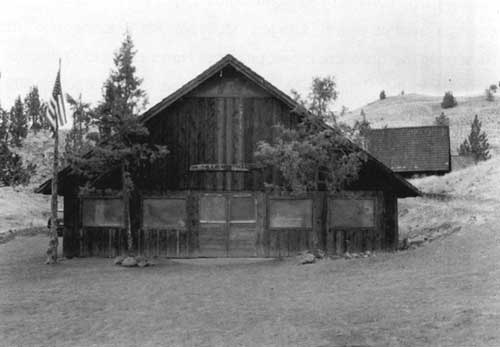|
John Day Fossil Beds Historic Resources Study |

|
Chapter Seven:
PALEONTOLOGICAL EXPLORATION (continued)
Cultural Resources Summary
Paleontological explorations constitute an exceptionally important theme in the human history of the John Day basin. Belatedly explored and sparsely settled due to its difficult access, the region was bypassed by some of the larger events of Pacific Northwest history. Other themes of the area's economic development — mining, ranching, and logging — have played a sustained but less visible role. None constitute the region's claim to fame in the wider world. By contrast, the fossil beds and their exploration have placed Grant and Wheeler counties in the limelight for more than a century. As a destination for scientific exploration and inquiry, the fossil beds gained national renown as early as the 1870s. Later, as efforts took shape to explain the area's rich geological history to the general public, visitation to the remote region increased, and the foundations of a local tourism industry were laid.
From the first documented wanderings of Thomas Condon in the mid-1860s, through the mid-twentieth century and beyond, visiting scientists and scholars have camped, prospected, and labored in the vicinity of the Monument. Some of their field journals and subsequent articles mention the places where they camped or searched for fossils. But most of these references are frustratingly vague, describing only general localities and nearby geographic features. Such broad references are made in the literature to Condon's explorations in the vicinity of Bridge Creek and around Sheep Rock in Turtle Cove, and to J.C. Merriam's forays into the Blue Basin. Somewhat more specific are references to particular places which served as base camps or prospecting sites. These include Sternberg and Wortman's 1878 collections at the Van Horn Ranch, and their base camp at the Mascall Ranch south of Picture Gorge, as well as J.C. Merriam's 1899 base camp at Allen's Ranch on Bridge Creek and prospecting on the Loup Fork (Mascall) beds on Cottonwood Creek.

Fig. 60. Berrie Hall at Hancock Field
Station; F.K. Lentz 1996 (National Park Service).
The presence of these visiting scientists and their interactions with local ranchers was nonetheless transitory, most lasting no longer than a few days or a single season at most. In their travels through the upper John Day basin, small parties of fossil hunters left no visible marks on the land. Because of this transient use and lack of location specificity, sites associated with fossil hunting are problematic in terms of identification and evaluation for listing in the National Register of Historic Places. The level of detail required to ground-verify locations of camps and collecting sites has not been uncovered in this study. Thus, no sites of this category within the Monument or its general vicinity have thus far been identified as eligible for listing in the National Register.
Within the boundaries of the Monument one site does appear to have clear potential for listing in the National Register in the near future. Camp Hancock (now called the Hancock Field Station) is a ten-acre inholding within the Clarno Unit, owned and operated by the Oregon Museum of Science and Industry. Now nearly fifty years of age, Hancock Field Station is a specific locale that has played a continuing role in paleontological research since 1951. Even more critical has been its role in science education for the general public. The camp complex includes Berrie Hall, a board and batten-clad dining and assembly hall, the oldest structure on site. Arranged around Berrie Hall in a narrow canyon are various laboratories, display sheds, and housing in the form of clusters of small A-frame cabins. The camp's simple wood-frame buildings were added over time, the most recent additions being A-frames brought in from Rajneeshpuram, the failed religious commune at Antelope.
Recommendations for further investigation of cultural resources associated with the context of Paleontological Explorations include:
Encourage and/or assist Oregon Museum of Science and Industry in documenting the historical development of Hancock Field Station for possible nomination to the National Register, when the facility reaches fifty years of age in 2001. Consider potential inclusion of nut beds and mammal quarry as associated paleontological features.
Provide closure to the question as to whether sufficient site-specific information exists for National Register determinations of eligibility, by documenting all locales associated with the movements of pivotal early-day fossil-hunters in the vicinity of the Monument. Using expedition journals and historic field photographs, revisit base camps, field camps, prospecting locales, and important discovery sites. Wherever possible, verify, map, and photographically record precise locations. Assess for significance within overall context of paleontological explorations in the John Day basin.
| <<< Previous | <<< Contents >>> | Next >>> |
joda/hrs/hrs7d.htm
Last Updated: 25-Apr-2002